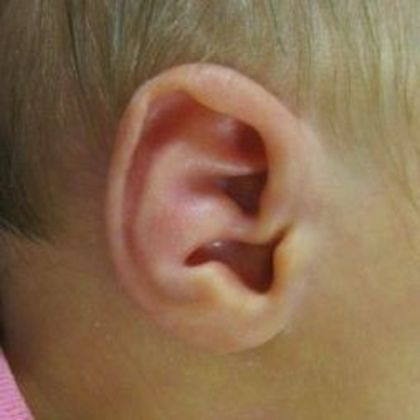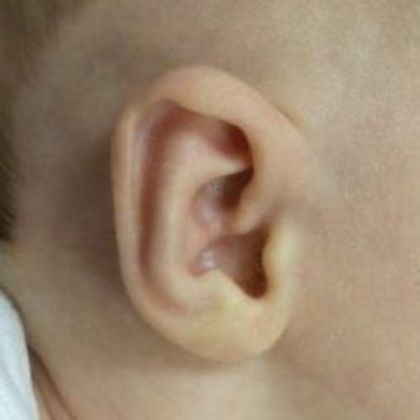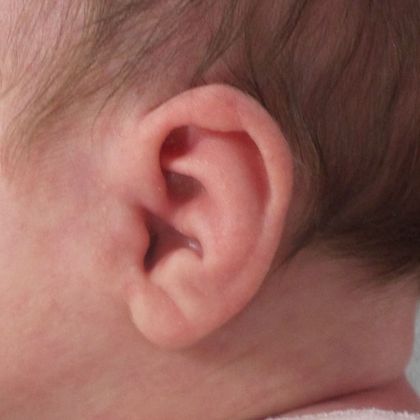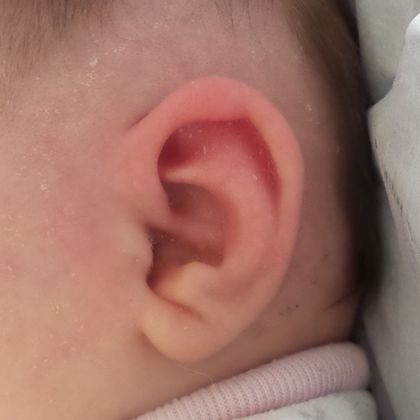Conchal crus deformities of the ear are rare by themselves, but often present with other ear deformities. Parents often call the office and state there is an extra fold of cartilage across the middle of the ear. Ear molding for conchal crus deformities is very effective when performed in the first few weeks after birth. At Dr. Jandali’s office, he uses customized molds on the ear to correct conchal crus deformities as well as any associated ear deformities at the same time.
What is Conchal Crus Ear Deformity?
The conchal crus is an abnormal fold of cartilage across the hollow middle part of the ear. It’s a section of cartilage that crosses over the conchal bowl, dividing the ear in half and causing it to bulge outward. This cartilage fold can obstruct the ear canal entrance.
Conchal crus deformities can often appear with other deformities, causing mixed ear deformities. As a congenital condition, there’s currently no known cause for how it develops, and it is usually present at birth. A conchal crus can be mild or very protuberant and severe. This condition doesn’t cause hearing loss or difficulties for newborns, but is considered a relatively underdiagnosed ear condition in infants.
Non-Surgical Correction in Babies with Conchal Crus Ear Deformity
Conchal crus deformities can be corrected through ear molding, a non-surgical treatment that helps reshape the ear using silicone prosthesis. The prosthetic is placed along the area of protuberant cartilage, providing steady, downward pressure on the conchal crus. This gradually flattens the deformed fold of cartilage until it is smooth like the rest of the conchal bowl. Ear molding works best for newborns during the first few weeks of life to mold and reshape the ear back to a healthy-looking shape.
For parents seeking options for their infant’s ear shaping procedure, ear molding can be your solution. As the best non-surgical treatment option for ear deformities, ear molding is considered highly successful due to its benefits:
- Responsive: The infant’s ears have high maternal estrogen levels, causing the ears to be pliable and soft. As they grow, the estrogen levels fall to normal ranges, becoming more rigid and less pliable.
- Painless: Because your infant’s cartilage inside the ear is soft and malleable, ear molding is painless and does not cause excessive pressure on the ear.
- Effective: The prosthesis device is worn 24/7 for one to two weeks, and then the ear is checked for improvement. Another mold usually has to be placed to continue molding and solidify the improved appearance.
- Non-Surgical: Most of all, ear molding is an excellent nonsurgical option for parents with newborns who have ear deformities. It can also prevent your baby from seeking surgery later on in life.
Ear Molding for Newborns with Conchal Crus Ear Deformity
If you have a newborn with conchal crus deformities, then non-surgical ear molding can provide their ears with a normal shape and appearance. Dr. Jandali offers non-surgical ear molding treatment for baby conchal crus deformities at his practice in Connecticut. During your infant’s visits, Dr. Jandali will mold and monitor their progress to ensure they receive naturally shaped ears with safe, gentle ear molding. For more information, contact Dr. Jandali’s office today to discuss your baby’s treatment options.
Conchal Crus Correction Gallery






